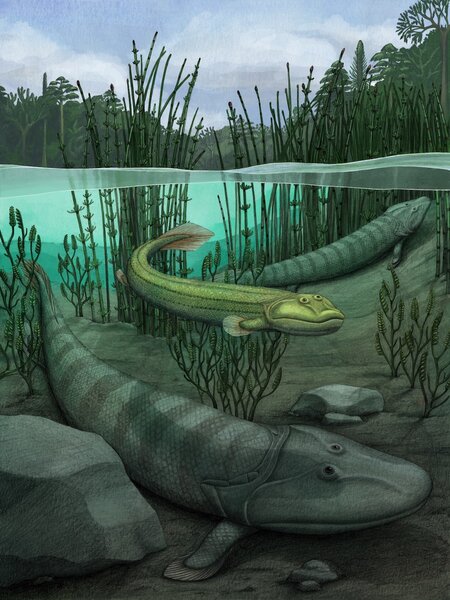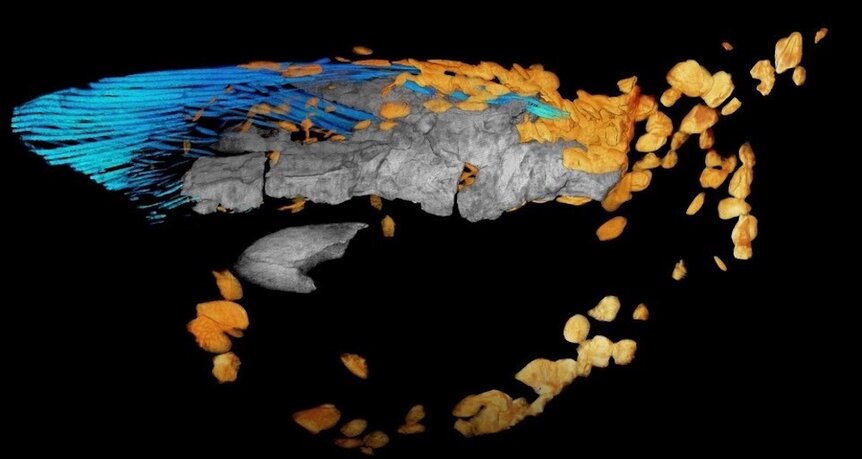Create a free profile to get unlimited access to exclusive videos, sweepstakes, and more!
This fishy animal ventured on land and immediately went back to the water
Qikiqtania pulled a rapid evolutionary about-face.

Have you ever wished you could go back in time and change something? It’s easy to imagine that one simple flip of a switch might send the rest of your existence spiraling in a totally different direction. That’s the premise behind the movie About Time in which Tim Lake (Domhnall Gleeson) attempts to alter the events of his past in order to build a different future. It’s also the premise behind a common joke in which people wish our ancient animal ancestors had never left the water, in order that we might avoid the stresses of modern human life.
Now, a newly discovered fossil reveals that our ancestral line could have returned to the oceans, if only things had been a little bit different. Thomas Stewart, then working out of the Department of Organismal Biology and Anatomy at the University of Chicago, is the lead author of a paper recently published in the journal Nature describing the new animal.
The specimen was found in the arctic and dubbed Qikiqtania, in honor of the Inuit communities who supported the expedition. When it was uncovered in 2004, it wasn’t immediately apparent that paleontologists had found something new. At first glance, researchers noticed some exposed scales and a bit of the jawbone, and that was enough for them to collect it and take it back to camp. Most of the rest of the expedition was spent digging up Tiktaalik fossils, and the remains of Qikiqtania were stored for later examination.
“The materials were taken to Philadelphia where they were physically prepared so we could better expose parts of the jaw and the teeth. But it wasn’t until we brought them to the University of Chicago and began scanning the materials that we discovered the completeness of it and that the fin was, in fact, preserved. That wasn’t something that was recognized when it was first collected,” Stewart told SYFY WIRE.
To look inside, the team used CT scanners to take a series of X-rays. Because X-rays give you information in only one direction, they had to take a picture then rotate the material a little before taking another picture. That process continued until they had a complete sequence of images covering the entirety of the material.
“Once you have a full radial series, you can use that and reconstruct slices through the object. That’s what we use to reconstruct. Then we spent a lot of time trying to make renderings and convert it into animations or graphics or tools for 3D printing,” Stewart said.
Their analysis revealed some significant differences between Qikiqtania and Tiktaalik which suggest that it adapted for living on land and then pretty quickly changed its mind and went back to the water. Looking just at its head, you might mistake it for Tiktaalik, the animal which is often blamed for us having to be here at all. In fact, researchers first suspected Qikiqtania might have been a juvenile Tiktaalik, owing to its comparatively small size but similar features. Once they looked behind the head, however, things were noticeably different.
“When we focus on the pectoral fin, we see a lot of differences. The way in which the fin is constructed, the shape of the bones, and the way the muscles would have attached, all of that is different,” Stewart said.
To understand some of what was happening inside Qikiqtania, we can look at modern animals which once lived on land before returning to the water. Dolphins and whales, for instance, famously made a retreat back to the oceans after spending long enough on land to evolve into mammals. When they did, their limbs splayed out and became flippers. Without that expansion of the limbs, they wouldn’t be able to manipulate their watery environment as well. A similar change back to flipper-like appendages was seen in Qikiqtania. The discovery helps to reveal the complexity of evolution and dispels the popular notion that organisms evolve in one direction, from water to land, from four legs to two, and so on.
“Because we have had so few representatives, our understanding of this part of history has tended to be reconstructed as a progression from water to land. Most evolutionary scenarios involve species radiating in any number of directions. In a sense, many scientists, if they spent time working on this problem would have predicted that we’d discover a range of forms and discover patterns of variation in direction. Not just from water to land but perhaps also from land to water. It’s really having a specimen that’s beautifully preserved that allows us to talk about this for the first time,” Stewart said.
That we ended up here on land, working our jobs and paying bills, but also watching movies with friends and exploring the universe, is a simple consequence of having followed one lineage instead of another. Had we followed Qikiqtania back into the water, things might have been different. But, as Tim Lake ultimately learns, no matter how hard you try you can’t really change the past.




























